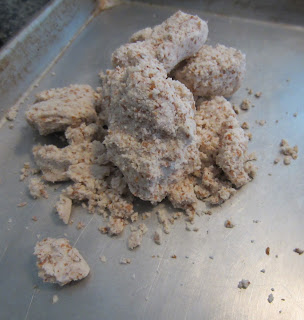Dip a piece of chicken into some melted ghee. Adding diced garlic to the ghee gives the chicken nuggets even more flavor.
Roll the piece of chicken in coconut flour that has been seasoned with sea salt, cumin, and Italian seasoning. Feel free to use other herbs/spices instead.
Place the chicken nuggets on parchment paper that has been placed in a pan. I greased the parchment paper with ghee, and after a few batches have found that isn't necessary.
Steam broccoli and carrots while the chicken nuggets are baking. Make sure to smother them in ghee before eating as well :-)
Enjoy!
Ingredients
- 1 lb free range chicken thighs
- 1/3 cup ghee, melted
- 2 cloves garlic, diced
- 1 cup coconut flour
- 1/2 tsp sea salt
- 2 tsp's cumin
- 1 tsp Italian seasoning
Directions
- Preheat the oven to 375 and place a piece of parchment paper on a large cookie sheet.
- Chop the chicken thighs into 2-3 inch strips.
- In a small bowl melt the ghee and mix in the diced garlic.
- Pour the coconut flour, sea salt, cumin, and Italian seasoning into a medium bowl and whisk together.
- Use tongs or your fingers and roll a strip of chicken in the ghee. Then roll it in the coconut flour mixture until it's well coated. Set the chicken nugget on the cookie sheet. Repeat this step until all of the chicken is on the sheet leaving a little space in between each nugget.
- Bake for 15 minutes, then broil on low until the nuggets have browned up a bit.
- Remove from the oven, let cool and enjoy!
































